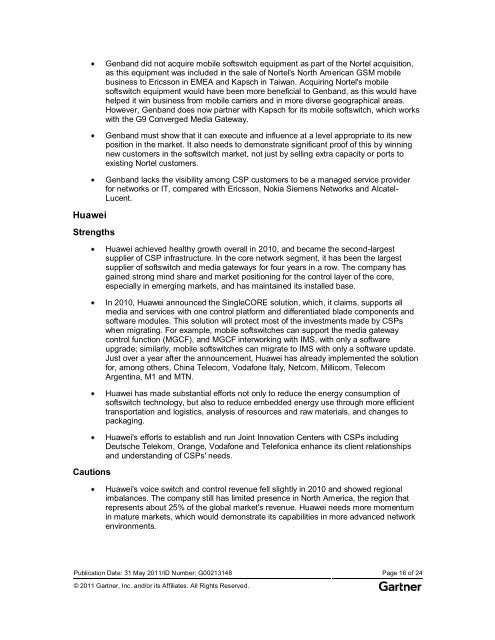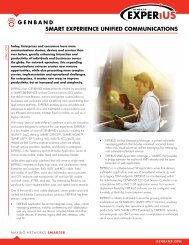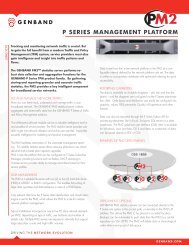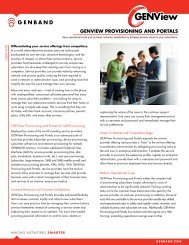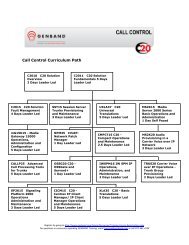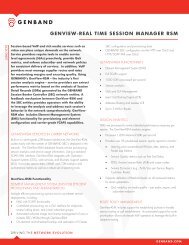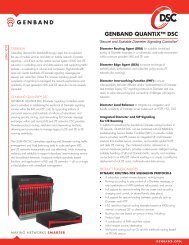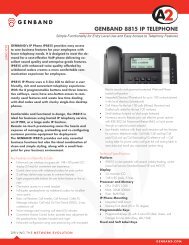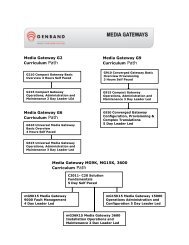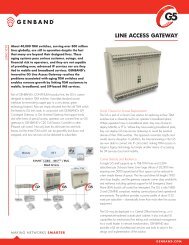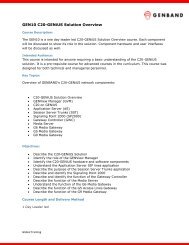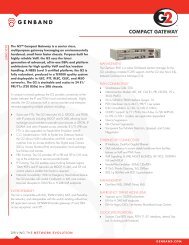Research Magic Quadrant for Softswitch Architecture - Genband
Research Magic Quadrant for Softswitch Architecture - Genband
Research Magic Quadrant for Softswitch Architecture - Genband
You also want an ePaper? Increase the reach of your titles
YUMPU automatically turns print PDFs into web optimized ePapers that Google loves.
Huawei<br />
Strengths<br />
Cautions<br />
<strong>Genband</strong> did not acquire mobile softswitch equipment as part of the Nortel acquisition,<br />
as this equipment was included in the sale of Nortel's North American GSM mobile<br />
business to Ericsson in EMEA and Kapsch in Taiwan. Acquiring Nortel's mobile<br />
softswitch equipment would have been more beneficial to <strong>Genband</strong>, as this would have<br />
helped it win business from mobile carriers and in more diverse geographical areas.<br />
However, <strong>Genband</strong> does now partner with Kapsch <strong>for</strong> its mobile softswitch, which works<br />
with the G9 Converged Media Gateway.<br />
<strong>Genband</strong> must show that it can execute and influence at a level appropriate to its new<br />
position in the market. It also needs to demonstrate significant proof of this by winning<br />
new customers in the softswitch market, not just by selling extra capacity or ports to<br />
existing Nortel customers.<br />
<strong>Genband</strong> lacks the visibility among CSP customers to be a managed service provider<br />
<strong>for</strong> networks or IT, compared with Ericsson, Nokia Siemens Networks and Alcatel-<br />
Lucent.<br />
Huawei achieved healthy growth overall in 2010, and became the second-largest<br />
supplier of CSP infrastructure. In the core network segment, it has been the largest<br />
supplier of softswitch and media gateways <strong>for</strong> four years in a row. The company has<br />
gained strong mind share and market positioning <strong>for</strong> the control layer of the core,<br />
especially in emerging markets, and has maintained its installed base.<br />
In 2010, Huawei announced the SingleCORE solution, which, it claims, supports all<br />
media and services with one control plat<strong>for</strong>m and differentiated blade components and<br />
software modules. This solution will protect most of the investments made by CSPs<br />
when migrating. For example, mobile softswitches can support the media gateway<br />
control function (MGCF), and MGCF interworking with IMS, with only a software<br />
upgrade; similarly, mobile softswitches can migrate to IMS with only a software update.<br />
Just over a year after the announcement, Huawei has already implemented the solution<br />
<strong>for</strong>, among others, China Telecom, Vodafone Italy, Netcom, Millicom, Telecom<br />
Argentina, M1 and MTN.<br />
Huawei has made substantial ef<strong>for</strong>ts not only to reduce the energy consumption of<br />
softswitch technology, but also to reduce embedded energy use through more efficient<br />
transportation and logistics, analysis of resources and raw materials, and changes to<br />
packaging.<br />
Huawei's ef<strong>for</strong>ts to establish and run Joint Innovation Centers with CSPs including<br />
Deutsche Telekom, Orange, Vodafone and Telefonica enhance its client relationships<br />
and understanding of CSPs' needs.<br />
Huawei's voice switch and control revenue fell slightly in 2010 and showed regional<br />
imbalances. The company still has limited presence in North America, the region that<br />
represents about 25% of the global market's revenue. Huawei needs more momentum<br />
in mature markets, which would demonstrate its capabilities in more advanced network<br />
environments.<br />
Publication Date: 31 May 2011/ID Number: G00213148 Page 16 of 24<br />
© 2011 Gartner, Inc. and/or its Affiliates. All Rights Reserved.


